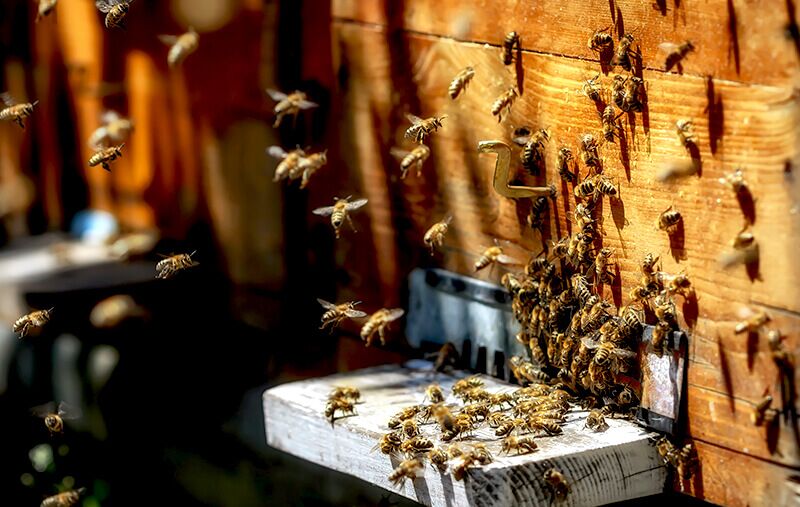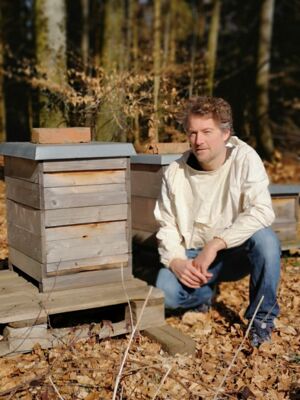What bees tell us about SAP processes
| Julia Pedak
Doxis and SAP – Stephan Kiemel, SAP consultant at SER, is fascinated by their interplay. Outside of work, he spends his spare time as a beekeeper and is inspired by the perfect symbiosis of bee colonies. Whether in his hobby or professionally, the graduate in business mathematics is always looking for the best solution for complex processes. We asked him about his daily work with Doxis and SAP and how it's impacted by his passion for beekeeping.

Stephan, you have been a SAP consultant at SER for over ten years now. What do you find fascinating about your work?
As an SAP consultant, I never get bored. In addition to programming, I support colleagues in sales, lead projects and also take care of maintenance and service issues. My twin passions are SAP Invoice Management and SAP Workflow programming. Workflow is used everywhere. I’m always gaining new insights into a variety of departments in the company: in HR when it comes to the SAP HR module and Doxis personnel eFiles, or in production, where a company wants to map document-based workflows. It's exactly the variety that makes it exciting. I also spend an average of one or two days a week with our customers on site, with a very broad audience: from users in departments to IT and management. That's the beauty of working at SER, the diversity of project work: e.g. in mechanical engineering, automotive, retail, chemical and food industries or banks, insurance companies and the media. I always find myself looking outside the box.

Automate inbound invoices
Capture, verify and approve: Find out how you can integrate Doxis InvoiceMaster into SAP and other ERP systems, automate invoice processes and thus minimize throughput times and personnel costs, reduce the error rate, and avoid late payments.
Read nowHow do you manage to keep adapting to new challenges and customer projects?
I’m good with people. My strength is that I build strong personal relationships with many customers and can talk to them directly about their needs. Of course, my many years of experience help me here. I am now familiar with a lot of successful process solutions from different companies, and I can advise customers very well about what is technically possible with SER and SAP. Apart from that, I'm always curious: What makes a company tick? What do employees expect? How do the processes look and which is the best solution that we can offer with Doxis? I am always looking for the best process.
When do you know that you’ve found “the best process”?

SER Professional Service
When the customer is satisfied. I can only achieve this through a well-planned, end-to-end process that provides added value for the company. For me, the best moment of a project is when I get feedback that our solution helps in daily business and makes work easier for people. At the beginning, some employees are understandably worried that process automation will eliminate their jobs. But I see it very differently. By making your in-house processes more efficient, you can do more with the same staff. That’s the key: Today, companies have to be positioned very efficiently in order to keep up with competitors. Process improvement is the major benefit I see in our products.
Why are such process improvements possible with Doxis?
Doxis provides an incredibly strong platform with a very modern, flexible architecture. Our customers can connect it to any application. This is extremely important in the interplay between SAP and Doxis. With Doxis SmartBridge for SAP, we have taken a big step forward. I also advise all of my customers to use it. SmartBridge is very easy to integrate using standard SAP functions, without any ABAP programming. Doxis functions such as search are then simply integrated in the SAP GUI. Doxis is an essential component in SAP projects and is closely linked to core processes. Only when the two come together will you be able to provide information at any time.
Seamless integration of Doxis & SAP
Indexing SAP documents, assigning files and processes, archiving and also searching outside of SAP: Doxis SmartBridge for SAP enables all of this. Find out more about the SAP connector here.
Read now
Is that not possible with SAP alone?
No, unfortunately it’s not that easy. In SAP, our customers find all the data about a transaction, for example, for a purchase order. But what about the documents attached to it? In SAP you can only find the main documents. Emails from suppliers, their certifications, all documents relating to the quote and purchase order up to the invoice: All of that is missing in SAP. Doxis brings together this information and provides you with a complete overview. This also includes documents and data from other systems, such as CRM, CAD or in-house specialist applications and databases. The nice thing is that cross-system workflows can be designed: If one of our customers adds a new supplier in SAP, for example, Doxis automatically creates the supplier file in which you can find all the information. Thanks to the integration, it doesn't matter whether you are in Doxis or SAP. The entire order process can be traced using both systems.
In the future, Fiori will set the tone in the world of SAP...
I agree. With our Fiori app, we already have the right solution for invoice verification. We have big plans for the further integration of Doxis so that companies can continue to work with Fiori or when changing to SAP 4/HANA. No matter where the journey takes us, I know we can do it and master projects. I trust in my colleagues at SER. We have many capable and hardworking people in our company who are always making our product better.
Hardworking like bees, which brings us to your hobby ...
Yes, I am a beekeeper in my spare time, for almost as long as I’ve worked at SER. A friend recommended a book about beekeeping to me, and then I took an intensive course. I was fascinated by beekeeping. It’s very outcome-oriented. At the end of the season, you see what you have achieved, which is sometimes difficult to grasp in the IT world. And I was amazed from the start by how a bee colony is organized, how it gets through the year, and who performs which tasks. You can follow the seasons of the year very closely, the weather and when certain plants bloom. And, of course, it's nice to have a full bucket of honey at the end of the year.
What kind of tasks does a beekeeper have?
It varies a lot. In the spring, depending on the weather, I begin work on the beehive in March. And then I have to take care of the colony's development for six to eight weeks. That means making sure they have enough space or adding a frame, if necessary, where they collect honey. Above all, I have to check the mood of the hive every seven days. If the bee colony tries to grow another queen, I have to prevent that. I pull out each honeycomb and look for a queen cell, which I then remove. Because as soon as a new queen develops, the old one gets ready to take off and takes many bees with it. That would be the end of the honey harvest. However, I also breed one or two new colonies every year to make up for losses. The first harvest will be at the beginning of June and, in a good year, another in late July. After that I get my colonies ready for winter and then have very little to do, except to feed them occasionally. Because I took their winter store of honey.
Your hobby also gives you ideas for your daily work. What can an SAP consultant learn from nature?
I learn to question my actions at the end of each year. By doing so, beekeepers can learn how the harvest went and whether their colonies are healthy and alert. If it doesn't look good, you have to do root cause investigations and take countermeasures next year. There is a great parallel here to my work as an SAP consultant: I am continuously checking whether there is room for improvement. In the new bee year, as in the new project, I have to be sensitive. None is like the previous one. I get involved with something new every time and find solutions that fit the existing conditions. My bee colonies are healthy and very strong because I follow a few basic rules and otherwise give them the freedom that they would have in nature. This is no different for processes with Doxis or SAP. If they are to work well, you need rules, but also ways to stay flexible.
What are you looking forward to when you think about the next few years with Doxis and SAP?
I’m looking forward to new technology. There is a lot to do and we are on the right track by continuing to develop our SAP department at SER. This will enable us to survive long-term in the market, and I’ll be able to look forward to proudly offering our customers new products. Of course, it’s also a challenge to develop and offer something new. But that's exactly what I enjoy. As a beekeeper and as a consultant I know that the only constant is change. Wherever the journey leads, I want to be onboard.
The latest digitization trends, laws and guidelines, and helpful tips straight to your inbox: Subscribe to our newsletter.
How can we help you?
+49 (0) 30 498582-0Your message has reached us!
We appreciate your interest and will get back to you shortly.







